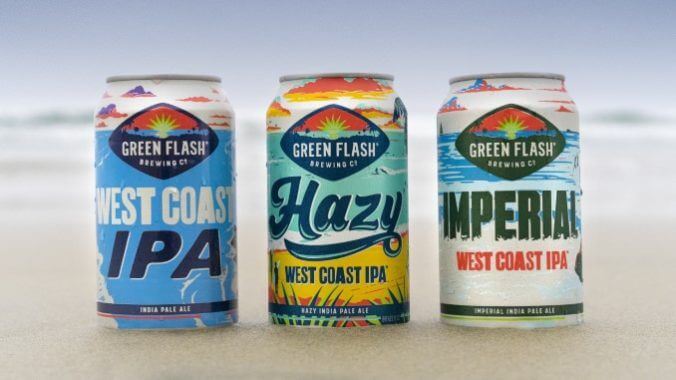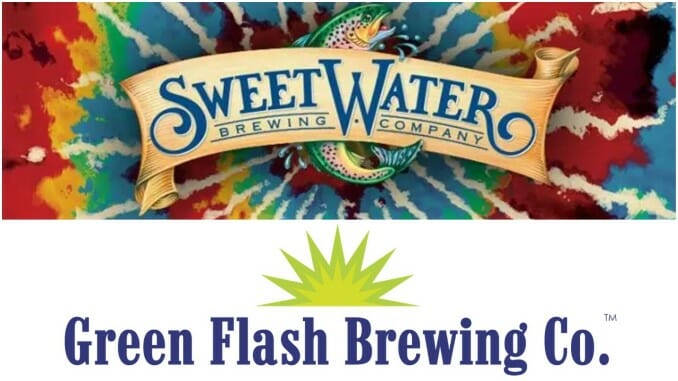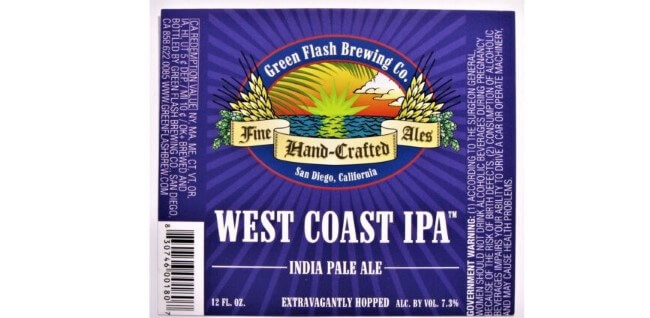Tasting: Revisiting 3 Flagship “West Coast” IPAs From Green Flash Brewing
Photos via Green Flash Brewing, Tilray Brands
It can be wild at this point to remember what the American craft beer landscape was like even five years ago. Enthusiasm was boundless and unshakeable. Hazy, juicy IPAs were redefining how craft beer geeks imagined the idea of “hop flavors.” And venerable, respected companies like Green Flash Brewing were pumping millions of dollars into East Coast expansions, trying to keep pace with all the other regional craft beer powerhouses making subsequent plays to become truly national names.
Suffice to say, things didn’t exactly pan out for a lot of these breweries. Growth slowed, and increasingly turned toward tiny local taprooms rather than mid-sized regional staples. Hundreds of new breweries continued to open per year, ignoring an increasingly crowded field. The likes of Stone Brewing and Modern Times became emblematic of those larger regional breweries that expanded too quickly in this era, closing multiple outposts and taprooms. But no company seemed to sum up the challenges of this era, and the struggle to survive, quite like Green Flash.
As recently as 2017, Green Flash was ranked in the Brewers Association’s 50 largest American craft breweries, with a massive and newly opened East Coast headquarters in Virginia Beach. Founded in 2002, it had flourished in the second great craft beer boom, with its iconic Green Flash West Coast IPA becoming an eponymous and beloved representation of that style. But its push to go national had come at exactly the wrong time, as mounting debts and slower than expected growth ultimately stopped the brand in its tracks, leading to massive contraction and then a complete collapse. At that time in mid-2018, it became very confusing to even suss out who exactly owned the Green Flash brand—not to mention Alpine Beer Co.—and the beer lineup saw subsequent rebranding attempts that craft beer drinkers couldn’t really help but interpret as death throes.
Today, however, the Green Flash brand feels more stable than it has been for a while, following its acquisition at the end of 2021 by SweetWater Brewing owner/Canadian cannabis giant Tilray. Green Flash and Alpine brands are now being produced in all Tilray-owned facilities, and they’ve seen themselves redesigned yet again, but I’ve never been particularly interested in labels or can art. What I find myself wondering is this: How do these classic IPA brands hold up in 2022? After years of turmoil, can Green Flash West Coast IPA feel like a major brand once again? Has the juicy era left this kind of IPA behind, and has the most recent iteration been modernized in some way?
A tasting of the core Green Flash IPAs, as they exist today, seemed in order. And so, that’s exactly what we have here today. All three are available nationally, in 12 oz cans.

Green Flash West Coast IPA
The beer that built the company, the original Green Flash West Coast IPA has been redesigned and reformulated several times over the years, so it’s hard to say exactly how much in common this beer has with the brand that was being packaged in the mid-2000s. It is, however, at the original 7% ABV, after the beer had for a period been redesigned in a stronger format at 8.1% ABV. And all in all, in tasting this one, it feels quite reminiscent of my memories, best encapsulated by the old-school label below—that’s how I tend to remember this brand.
The current iteration of West Coast IPA pours with a nice, creamy head of foam, and features an appealing nose of pine needles, mild resin and bright citrus, particularly of grapefruit and lemon zest. It has fresh, floral elements as well, along with hints of toasted malt underneath, and a suggestion of biscuit. On the palate, this one features toasted bread crust and moderate malty sweetness, along with moderate-to-high bitterness. The hops are trending toward the floral and resinous side, with hints of grapefruit poking through as well, and a slightly marmalade-like bitterness and pithiness. All in all, this one is well balanced and fairly drinkable, although the bitterness here might seem strong to those who have been reared primarily on hazy IPA in the last five years. It doesn’t shy away from the bitterness that drinkers all used to expect in this style of IPA, nor the malt balance that was once taken for granted.
All in all, I feel like this IPA is still the crown jewel of this lineup, and the most balanced expression of the three. It finds the best, happy medium between its influences, and is a vital example of the style of beer we all once recognized as West Coast IPA. And given how the words West Coast IPA have been redefined more recently, I rather worry that beers like this may be the last vestige of the style as it once was.
 The era of Green Flash West Coast IPA that I came of age with.
The era of Green Flash West Coast IPA that I came of age with.
Green Flash Hazy West Coast IPA
I don’t begrudge Green Flash creating a flagship hazy IPA one bit—in this market, it would be crazy to not have a go-to hazy or juicy brand of your own to sell, even when you’re associated with an older style of IPA. With that said, calling it “Hazy West Coast IPA” feels like a deliberate oxymoron, and a little bit ridiculous. In terms of what they’ve made here though, the name is actually quite apt, because this 6.5% ABV beer turns out to have more in common with the original West Coast IPA than I was expecting.
The color is notably lighter, and it’s certainly plenty turbid, but the most surprising thing here is how this Hazy West Coast IPA manages to preserve some elements of the original’s malt profile regardless, a quality that is pretty foreign in the world of hazy IPA. On the nose, you certainly get the hops first—I’m getting lots of orange, florals and dank notes, but the unexpected element is significant black tea-like maltiness.
On the palate, these elements are all pretty vibrant, with big notes of juicy orange and peach—possibly passionfruit—along with slight vanilla and some dankness. But there’s that malt again, a little bit of black tea balance hidden in there. Notably, it doesn’t have the bitterness of the regular West Coast IPA; that element has indeed been discarded. But thankfully it’s also not too sweet when all is said and done, rendering the juiciness a bit more ephemeral than syrupy. I do find myself missing a modicum of bitterness, however, and I wonder it perhaps this brand might be more exciting with that bitterness still intact.
Green Flash Imperial West Coast IPA
This is basically a straightforward, scaled up version of West Coast IPA, weighing in at 8.9% ABV. It feels a bit old school all around, even in the use of the term “imperial,” which is increasingly discarded in the IPA world these days.
That extra 1.9% ABV certainly makes a big, expressive difference to this beer, however. On the nose, it strikes me as significantly less hop-forward than the classic West Coast IPA was, with malt tones that have moved further into the foreground. Copious amounts of toasted bread crusts, black tea and subtle red fruitiness have taken center stage, supported by slightly vinous ethanol. The hops, meanwhile, trend more toward the grassy and floral, and it’s more difficult to pick up the brighter citrus that was present on the nose of the flagship IPA.
The hops present somewhat more on the palate, with grassy and resinous tones, but Imperial West Coast IPA is also significantly malty-sweet, with stray notes of biscuit, licorice and light booziness. The presumed crystal malt speaks more here as well, with caramel and darker, dried fruitiness—you can feel the progression in the direction of the old-school interpretation of American barleywine. The sturdy bitterness that was absent in the Hazy West Coast IPA has been returned as well.
All in all, this feels like a nicely familiar return to the style of DIPA I remember regularly drinking 15 years ago. It doesn’t have the overall balance of the original West Coast IPA, but those who miss the earlier era of DIPA—especially those who enjoy when the style didn’t shy away from a little booziness—will likely find it quite appealing.
Jim Vorel is a Paste staff writer and resident beer and liquor geek. You can follow him on Twitter for more drink writing.







































